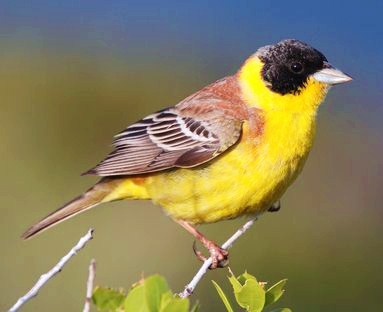Emberiza melanocephala
 |
| Photo by Mark Jobling (Wikipedia) |
Common name:
black-headed bunting (en); escrevedeira-de-cabeça-preta (pt); bruant mélanocéphale (fr); escribano cabecinegro (es); kappenammer (de)
Taxonomy:
Order Passeriformes
Family Emberizidae
Range:
This species is found breeding in southern Europe, from Italy and Greece to Turkey, and eastwards to Iran. They migrate south-east to winter in western and central India.
Size:
The black-headed bunting is 16-17 cm long and has a wingspan of 26-30 cm. They weigh 27-30 g.
Habitat:
These birds typically breed in mountain slopes, favouring fairly dense and tall bushy and scrub vegetation, including open maquis, wooded steppes, orchards, olive groves, and vineyards, and groves or thickets along streamsides, roadsides, or field borders. They are also found breeding in open forest with undergrowth and in open lowland grassland with scrub, especially thorn scrub. In winter they are usually found in scrub jungle and in cultivated fields.
Diet:
They mostly eat seeds and other plant material, namely cultivated crops including cereals and sunflower seeds. They also eat invertebrates, especially during the breeding season.
Breeding:
These birds breed in May-June. The nest is a loose, untidy foundation of stalks, grass, and leaves, lined with fine grasses, stems, rootlets, hair, and sheep’s wool. Often there are brightly-coloured flower-heads on outside the outside. The nest is usually placed in dense, often thorny shrub bramble, rose, rockrose, Christ’s thorn and commonly on vine. The female lays 4-5 pale grey to brown eggs which are incubated by both sexes for 13-15 days. The chicks fledge 13-15 days after hatching. typically each pair only produces 1 brood per season.
Conservation:
IUCN status – LC (Least Concern)
This species has a very large breeding range and a global population size of 10-50 million individuals. The population is suspected to be in decline owing to changing agricultural practices and the removal of hedges and shrubs from parts of its range.







